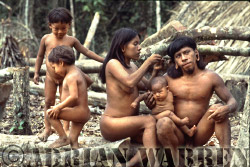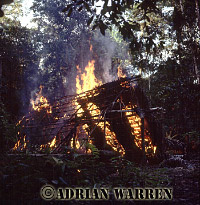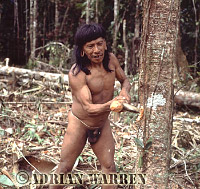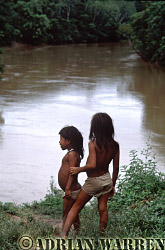WAORANI
The Saga of Ecuador's Secret People:
A Historical Perspective
© Adrian Warren, Last
Refuge Ltd., March 2002, in association with Dr. James Yost
 Waorani Indians: family grooming,
1983
Waorani Indians: family grooming,
1983 |
Amazingly, even amid the turbulent
way of life led by the Waorani, the underlying culture of the tribe
maintained strong social ties: an egalitarian society with no concept
of competition or rank, where children had nearly the same status
as adults. And there was greater equality between the sexes than
within Western culture between men and women, even if there were
separate roles; while men hunted, women planted the gardens and
prepared the food. They even used stone axes, treasured objects
and fiercely protected, found, remarkably, as archeological artifacts
in the forest, discarded by other peoples from another time. Living
as semi-nomadic hunter gardeners, and because of the violence, they
needed to roam a huge area in order to survive. |
They traditionally
lived in small groups of thirty to forty people, remaining in any
one place for only a few months, during which time they hunted,
prepared gardens for growing manioc, and took note of the whereabouts
of trees, vines, and other plants essential to their lifestyle.
While they harvested one garden, they simultaneously planted another
next to it. Once hunting in the area became less successful, they
burned the house and moved on, repeating the process at a new location,
and returning in time to harvest the gardens when the manioc was
ready. It was a cycle of life that was in equilibrium with their
forest home, but they were continually on the move, and that's why
they needed so much space. |
 Hut burning before
moving on, 1983
Hut burning before
moving on, 1983 |
 Caempaede using Stone
Axe, 1983
Caempaede using Stone
Axe, 1983 |
Traditionally,
the Waorani had no form of writing; no reason to count beyond ten;
and are one of those rare groups to be classified as linguistic
isolates - people whose language bears no resemblance to any other
in the world. Their ethnic origins are obscure: no one knows how
large their population may once have been. Their environment offers
almost insurmountable difficulties for archaeological research,
since their day to day material needs were mainly of plant origin
and are therefore ephemeral. |
Continuing his studies, Jim built a house in a
Waorani village and brought in his wife and children. During this period
at the Protectorate, there were up to two hundred Waorani lived in the
village of Tewaeno at any one time. Under the influence of the Missionaries,
they were learning to be peaceful with one another and to interact with
the outside world. Rachel Saint was busy translating the New Testament
into the Waorani language, and efforts were being made to contact any
Waorani communities still remaining in the old hunting grounds.
Dayuma, and her half Quichua son Sam, were themselves
becoming more integrated with the outside world and began to establish
a new settlement, not far away, at Tonaempaedi. While the more traditional
Waorani stayed at Tewaeno, those who moved to Tonaempaedi convinced the
Ecuadorian government to establish Spanish schools where the Waorani language
was no longer taught.
 Waorani Children, rio Cononaco,
1993
Waorani Children, rio Cononaco,
1993 |
Dayuma's son Sam wanted to establish some
tourist visits to traditional living Waorani. His attentions focussed
on Caempaede's group, since they had spent a short time at the Protectorate
and had therefore already experienced some contact. Sam promised
them a steady flow of presents if they would move from Gabado to
the Cononaco river, which was less remote for Sam's tours and where
one of the oil companies had built a large airstrip. Caempaede's
group moved, and a few tourists began to trickle in on sporadic
visits. Some of the visitors however also brought colds and flu,
resulting in several deaths in Caempaede's group. Jim Yost, whose
relationship with Caempaede's group was by now very close, travelled
back and forth to treat the sick, but the Waorani had no resistance
to these simple diseases, and more people died. After these bad
experiences, Caempaede moved his group upriver, away from the airstrip,
to keep away from outsiders and their diseases.
|
|
